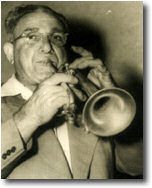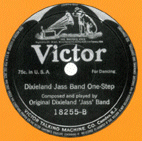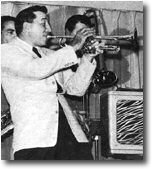Una storia nel Jazz – Nick La Rocca
Edizioni Novecento – price 20 Euros
The history of jazz is very recent, since it spans a little more than a century and many of the most famous leading figures who signaled its beginning have actively been on the scene almost up until today: Louis Armstrong, for example, died in 1971, Duke Ellington in 1974, Dizzy Gillespie in 1993 and Ella Fitzgerald in 1996. It is therefore a history that fully belongs to us as for closeness, personal experiences and direct witness. Still, as in many other circumstances, the knowledge we possess is too much simplified and schematic, frequently grounded on the easy and immediate charm of a broadly outlined study, at times based even only on clichés or amusing anedoctes, rather than on the historical, cultural and musicological analysis of those several and complex elements that, towards the end of the XIX century, contributed to the
birth of a new language destined to become, at first, an independent artistic expression and, later, the real soundtrack of the XX century. And it is just as a consequence of the modern trend that favors stereotypes and schematisms or, at best, accepts simplified and very abridged information that jazz is felt as a music form sprung up as if by magic in a well-defined moment and place (that is New Orleans) almost exclusively among the African deportees to the New World. Hence the more or less explicit corollary: only the blacks can play real jazz; the whites can only imitate them.
Recently published by Edizioni Novecento, "Una storia nel jazz: Nick La Rocca" by Claudio Lo Cascio, the doyen of Sicilian jazz players and most famous pianist, composer, arranger and orchestra director, explicitly states from the title the intent to tackle and discuss only a small and restricted aspect of that confused period when jazz developed: to give the right artistic dimension back to the life of Nick La Rocca, cornetist of Sicilian origin and leader of the  Original Dixieland Jazz Band, and to define his many merits with the help of the detailed documents gathered during several years of research and study, most of which directly carried out on the field, both in Sicily and in the USA. Had Lo Cascio just sticked to the specific subject of the title, jazz bibliography would have acquired a new testimony, maybe valuable for its scientific precision and wealth of comparisons, but certainly of specialist concern and, therefore, intended mainly for connoisseurs and experts. On the contrary, in its structure and development, Lo Cascio's book goes well beyond simple philology and, by going over Nick La Rocca's life, it tackles, in the quick and witty style of a reporter, the much wider and more general subject of the real contribution the white musicians gave to the birth and evolution of jazz. And furthermore, it defines with special attention and plenty of references the fundamental role played by the several musicians of Sicilian origin, dwelling also on the historical and social reasons that set up a daring and unexpected bridge between the Mediterranean island and the Mississippi Delta, which for many a decade was crossed by a steady stream of goods and, above all, men, whole families and personal stories hovering between despair, nostalgia and hope. Therefore, a reading definitely intended for the jazz expert, who will find detailed references to almost all the Sicilian musicians or those of Sicilian origin who, to a different extent, greatly helped jazz flourish. But at the same time, a reading that will deeply interest those who wish to better understand the reasons that made New Orleans the ideal stage for the birth of jazz. And most of all, a reading that will equally fascinate all those Sicilians interested in rediscovering to what degree our emigrants contributed to the evolution of 1900's American culture. For many years, Lo Cascio has passionately devoted himself to determine, develop and investigate such subjects, thus greatly contributing to the rediscovery and enhancement of La Rocca's compositions. Indeed, we owe to him the presence of three bronze busts of the New Orleans cornetist (he was born there on April 11, 1889) in the auditorium of Salaparuta, the small town near Trapani from which his father Girolamo emigrated in 1876, in the Louisiana State Museum and in the Conservatory "Vincenzo Bellini" of Palermo. And there must be a reason why in 1991 Lo Cascio was the first and, up till now, only Sicilian jazz player to be made a freeman of the City of New Orleans, the cradle of jazz. A new record that adds to the many others scattered along the noteworthy career of the Palermitan musician: first jazz concert in Sicily (1956), first jazz concert in Italy performed in a Conservatory (Palermo, 1958), first jazz concert for the "Amici della Musica" of Palermo (1962).
Original Dixieland Jazz Band, and to define his many merits with the help of the detailed documents gathered during several years of research and study, most of which directly carried out on the field, both in Sicily and in the USA. Had Lo Cascio just sticked to the specific subject of the title, jazz bibliography would have acquired a new testimony, maybe valuable for its scientific precision and wealth of comparisons, but certainly of specialist concern and, therefore, intended mainly for connoisseurs and experts. On the contrary, in its structure and development, Lo Cascio's book goes well beyond simple philology and, by going over Nick La Rocca's life, it tackles, in the quick and witty style of a reporter, the much wider and more general subject of the real contribution the white musicians gave to the birth and evolution of jazz. And furthermore, it defines with special attention and plenty of references the fundamental role played by the several musicians of Sicilian origin, dwelling also on the historical and social reasons that set up a daring and unexpected bridge between the Mediterranean island and the Mississippi Delta, which for many a decade was crossed by a steady stream of goods and, above all, men, whole families and personal stories hovering between despair, nostalgia and hope. Therefore, a reading definitely intended for the jazz expert, who will find detailed references to almost all the Sicilian musicians or those of Sicilian origin who, to a different extent, greatly helped jazz flourish. But at the same time, a reading that will deeply interest those who wish to better understand the reasons that made New Orleans the ideal stage for the birth of jazz. And most of all, a reading that will equally fascinate all those Sicilians interested in rediscovering to what degree our emigrants contributed to the evolution of 1900's American culture. For many years, Lo Cascio has passionately devoted himself to determine, develop and investigate such subjects, thus greatly contributing to the rediscovery and enhancement of La Rocca's compositions. Indeed, we owe to him the presence of three bronze busts of the New Orleans cornetist (he was born there on April 11, 1889) in the auditorium of Salaparuta, the small town near Trapani from which his father Girolamo emigrated in 1876, in the Louisiana State Museum and in the Conservatory "Vincenzo Bellini" of Palermo. And there must be a reason why in 1991 Lo Cascio was the first and, up till now, only Sicilian jazz player to be made a freeman of the City of New Orleans, the cradle of jazz. A new record that adds to the many others scattered along the noteworthy career of the Palermitan musician: first jazz concert in Sicily (1956), first jazz concert in Italy performed in a Conservatory (Palermo, 1958), first jazz concert for the "Amici della Musica" of Palermo (1962).  And speaking of records, the detailed analysis, resulting from directly gathered and scrupulously reported witness, is worthy of particular attention. Through it the author restores the truth about La Rocca's personal and artistic life and, above all, gives him
legitimate recognition for having made the world's first Jazz recording, namely "Livery Stable Blues" coupled with "Dixie Jass Band One Step", which he released with his Original Dixieland "Jass " Band (afterwards changed to Jazz) for Victor (the trademark known as "His Master's Voice" whose famous logo depicts a little dog curiously looking into the trumpet of a gramophone) on Februrary 26, 1917, that is eight years before Louis Armstrong's first
record as a band leader. The record was sensationally successful, more than
those of well-known figures like Enrico Caruso and John Philip Sousa, and the
sales touched inconceivable levels for that period: one million and half copies
at 75 cents each. Of great appeal is the research into the causes of the
migration of very many Sicilians, mainly coming from the west of the island, to
New Orleans and Louisiana, where a large and almost entirely Sicilian colony had
been founded, that at the end of the XIX century had more than twelve thousand
members. As Lo Cascio's research on the most represented families has pointed
out, the main reason for this exodus, involving both coastal (Termini Imerese,
Cefalù, Trabia, Agrigento, Sciacca,
And speaking of records, the detailed analysis, resulting from directly gathered and scrupulously reported witness, is worthy of particular attention. Through it the author restores the truth about La Rocca's personal and artistic life and, above all, gives him
legitimate recognition for having made the world's first Jazz recording, namely "Livery Stable Blues" coupled with "Dixie Jass Band One Step", which he released with his Original Dixieland "Jass " Band (afterwards changed to Jazz) for Victor (the trademark known as "His Master's Voice" whose famous logo depicts a little dog curiously looking into the trumpet of a gramophone) on Februrary 26, 1917, that is eight years before Louis Armstrong's first
record as a band leader. The record was sensationally successful, more than
those of well-known figures like Enrico Caruso and John Philip Sousa, and the
sales touched inconceivable levels for that period: one million and half copies
at 75 cents each. Of great appeal is the research into the causes of the
migration of very many Sicilians, mainly coming from the west of the island, to
New Orleans and Louisiana, where a large and almost entirely Sicilian colony had
been founded, that at the end of the XIX century had more than twelve thousand
members. As Lo Cascio's research on the most represented families has pointed
out, the main reason for this exodus, involving both coastal (Termini Imerese,
Cefalù, Trabia, Agrigento, Sciacca,  Trapani and Ustica) and inland towns like Monreale, Campofelice di Fitalia, Ventimiglia Sicula, Bivona, Corleone, Contessa Entellina, Piana dei Greci and Poggioreale, is to be traced to the frequent and direct sea connections between Palermo and New Orleans. Towards the end of the XIX century, Louisiana (whose capital is Baton Rouge) was one of the wealthiest American states and the city on the Delta, which had the complete control of the very thriving trade along the Mississippi, had quickly become the most crucial port of the United States for volume of business, just after New York. Connection between Sicily and New Orleans was provided by merchant ships and liners, for which the capital of the Island was a direct or an intermediate call. One of the about a hundred vessels Lo Cascio patiently recorded while examining the official microfilms of the United States Immigration Services covering fifty years (from 1861 to 1910) was the Montebello, a large steamship that, on a 25-day
journey, used to carry to Louisiana citrus fruit and about a thousand
immigrants, bringing back to Sicily mainly bales of cotton, that were moved to
Genoa to be converted into denim and, then, shipped again to the USA. The book provides plenty of detailed information, although collateral to the main story, about the large colony of Usticesi involved in this mass migration. It is the case of the Congregazione di San Bartolomeo Apostolo, founded in 1879 by Usticesi immigrants, which was probably the
oldest of the several mutual aid associations founded in that period. Besides,
Trapani and Ustica) and inland towns like Monreale, Campofelice di Fitalia, Ventimiglia Sicula, Bivona, Corleone, Contessa Entellina, Piana dei Greci and Poggioreale, is to be traced to the frequent and direct sea connections between Palermo and New Orleans. Towards the end of the XIX century, Louisiana (whose capital is Baton Rouge) was one of the wealthiest American states and the city on the Delta, which had the complete control of the very thriving trade along the Mississippi, had quickly become the most crucial port of the United States for volume of business, just after New York. Connection between Sicily and New Orleans was provided by merchant ships and liners, for which the capital of the Island was a direct or an intermediate call. One of the about a hundred vessels Lo Cascio patiently recorded while examining the official microfilms of the United States Immigration Services covering fifty years (from 1861 to 1910) was the Montebello, a large steamship that, on a 25-day
journey, used to carry to Louisiana citrus fruit and about a thousand
immigrants, bringing back to Sicily mainly bales of cotton, that were moved to
Genoa to be converted into denim and, then, shipped again to the USA. The book provides plenty of detailed information, although collateral to the main story, about the large colony of Usticesi involved in this mass migration. It is the case of the Congregazione di San Bartolomeo Apostolo, founded in 1879 by Usticesi immigrants, which was probably the
oldest of the several mutual aid associations founded in that period. Besides,
 it was right on board the Montebello that, on October 1897, Louis Prima's future mother, who was 11 months only, arrived in New Orleans. A trumpet player of good technique, an actor full of verve and spontaneity, an Armstrong-styled captivating singer and an interpreter destined for celebrity with pieces like"Ohi Marì", "Just a Gigolo", "Buona Sera", "Angelina" and "Sing, sing, sing" (the latter was made a smash hit by Benny Goodman and his orchestra in the 1938 legendary concert at the Carnegie Hall of New York), Louis Prima was born in New Orleans on December 7, 1911. His father, Anthony Di Prima, was born in New Orleans as well, but was the son of an immigrant from Salaparuta, while his mother, Angelina Caravella, had arrived from Ustica when she was just a baby. Although Louis Prima (who died in 1978) is not numbered among the giants of jazz, we recognize his extraordinary merit of having spread jazz language. His skill of talented entertainer, his vocal style now soft now breezy now hoarse, the alternation of Italian language and Sicilian dialect and, most of all, the irresistible and very pleasant blending resulting from the combination of New Orleans style, swing, jive and rhythm'n'blues earned him, especially towards the second half of the Fifties, the interest and enthusiasm of such a large audience that all the thousands of radio stations of the USA scheduled at least one of his hits.
it was right on board the Montebello that, on October 1897, Louis Prima's future mother, who was 11 months only, arrived in New Orleans. A trumpet player of good technique, an actor full of verve and spontaneity, an Armstrong-styled captivating singer and an interpreter destined for celebrity with pieces like"Ohi Marì", "Just a Gigolo", "Buona Sera", "Angelina" and "Sing, sing, sing" (the latter was made a smash hit by Benny Goodman and his orchestra in the 1938 legendary concert at the Carnegie Hall of New York), Louis Prima was born in New Orleans on December 7, 1911. His father, Anthony Di Prima, was born in New Orleans as well, but was the son of an immigrant from Salaparuta, while his mother, Angelina Caravella, had arrived from Ustica when she was just a baby. Although Louis Prima (who died in 1978) is not numbered among the giants of jazz, we recognize his extraordinary merit of having spread jazz language. His skill of talented entertainer, his vocal style now soft now breezy now hoarse, the alternation of Italian language and Sicilian dialect and, most of all, the irresistible and very pleasant blending resulting from the combination of New Orleans style, swing, jive and rhythm'n'blues earned him, especially towards the second half of the Fifties, the interest and enthusiasm of such a large audience that all the thousands of radio stations of the USA scheduled at least one of his hits.
Lastly, the closing chapters, very pleasant and enjoyable, in which Lo Cascio, on the basis of his frequent visits, tells how strong and deep-rooted the sense of belonging to the Sicilian culture and traditions still is starting, for example, with the devoutness for Santa Rosalia, whose intercession, according to the believers, stopped the anthrax epidemic that in 1899 had decimated the livestock at Kenner, a municipality of New Orleans. Since then the Santuzza is celebrated every year with the same spirit, the same banners, the same "vara" (coffin [translator's note]) and the same procession as in Palermo.
Wittily prefaced by Piero Volante, Lo Cascio's work, to be appreciated also for
the elegance of the fascinating iconography, ends with an appendix consisting of a series of detailed files: jazz players whose origin is undoubtedly Sicilian, jazz players whose origin is probably Sicilian, the discography of the Original Dixieland Jazz Band, the respective repertoire of the original compositions, the bibliography, the Italians in New Orleans and, finally, a most useful index of names.
Gigi Razete
Courtesy by:
Centro Studi e Documentazione Isola di
Ustica
Via Calderaro
1
90010 Ustica
tel e fax 091 8449 157
e mail centrostudiustica@tin.it
www.centrostudiustica.it

